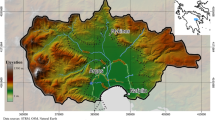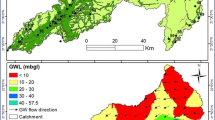Abstract
The theoretical foundations and principles of the use of fresh groundwater (FGW) and its role in combating desertification and the development of the biological potential of arid lands are presented. The advantages of FGW in comparison with surface irrigated water are revealed: protection from pollution, evaporation, and protection of natural reserves and their natural renewability. The areas of arid lands by continent, differences in the FGW depth, and the parameters of the recommended type of drip irrigation on the example of one of the arid regions of the Tersko–Kumskaya artesian lowland are given. The natural renewal and close occurrence on the FGW surface in the delta-alluvial plains of Eurasia is compared with the conditions of equatorial Africa.


Similar content being viewed by others
REFERENCES
Babaev, A.G., Historical-geographic analysis of dynamics of desert ecosystems, Probl. Osvoeniya Pustyn’, 1989, no. 5, pp. 18–25.
Balamirzoev, M.A., Qualitative evaluation of soils in Caspian Lowland in Dagestan, in Ekologicheskie problemy Prikaspiiskoi nizmennosti (Ecological Problems in Cis-Caspian Lowland), Makhachkala: Dagest. Nauchn. Tsentr, Akad. Nauk SSSR, 1997, no. 3, pp. 35–49.
Bazha, S.N., Gunin, P.D., and Kontsov, S.V., Experience of investigation of the hydrothermal regime of dark chestnut soils of Central Mongolia, Arid Ecosyst., 2012, vol. 2, no. 1, pp. 34–44.
Bogomolov, G.V., Gidrogeologiya s osnovami inzhenernoi geologii (Hydrogeology with Principles of Engineering Geology), Moscow: Vysshaya Shkola, 1975.
Dobrovol’skii, G.V., Rol’ i znachenie pochvy v stanovlenii i evolyutsii zhizni na Zemle (Role of Soil in Development and Evolution of Life on the Earth), Moscow: KMK, 2011, pp. 7–15.
Kerimkhanov, S.U., Effect of slop exposition on soil location in mountainous Dagestan, Pochvovedenie, 1973, no. 2, pp. 3–10.
Kunin, V.N., Linzy presnykh vod pustyni (Lenses of Fresh Waters of Deserts), Moscow: Akad. Nauk SSSR, 1963.
Kurbanov, M.K., Severo-dagestanskii artezianskii bassein (North Dagestan Artesian Basin), Makhachkala: Dagest. Knizhn. Izd., 1969.
Kurbanov, M.K., Mamaev, S.A., and Bazmanova, P.M., Resources and modern problems of pollution and rational use of underground waters of North Dagestan artesian basin, Nauchnaya konferentsiya “Resursy podzemnykh vod Yuga Rossii i mery po ikh ratsional’nomu ispol’zovaniyu, okhrane i vosproizvodstvu” (Sci. Conf. “Resources of Underground Waters of Southern Russia and Their Rational Use, Protection, and Recovery”), Makhachkala: Dagest. Nauchn. Tsentr, Ross. Akad. Nauk, 2009, pp. 40–46.
Mikhailov, L.E., Gruntovye vody (Ground Waters), Leningrad, 1982.
Mirzoev, E.M.-R., Gadzhiev, I.Sh., and Magomedov, Z.M., Theoretical substantiation of combat desertification in arid zones, in Ekologicheskie problemy Prikaspiiskoi nizmennosti (Ecological Problems in Cis-Caspian Lowland), Makhachkala: Dagest. Fil., Akad. Nauk SSSR, 1975, no. 3, pp. 11–16.
Plotnikov, N.A., Otsenka zapasov podzemnykh vod (Evaluation of Underground Water Resources), Moscow: Gosgeotekhizdat, 1959.
Salmanov, A.B., General trends in biological studies in Dagestan, Tr. Otd. Biol., Dagest. Fil., Akad. Nauk SSSR, 1956, no. 1, pp. 5–12.
Soldatov, A.S., Perspektivy rasseyaniya pochv Tersko-Sulakskoi nizmennosti Dagestana (Possible Dissipation of Soils of Tersko-Sulakskaya Lowland), Makhachkala, 1964.
Tolstikhin, N.I., Classification of underground waters, Tr. Leningr. Gorn. Inst., 1972, no. 2, pp. 48–60.
Vinogradov, B.V., Analysis of various indicators in desertification monitoring in Southern Russia, Arid. Ekosist., 1996, vol. 2, no. 2, pp. 38–47.
Zalibekov, Z.G., Pochvy Dagestana (Soils of Dagestan), Moscow: Nauka, 2010.
Zalibekov, Z.G., The arid regions of the world and their dynamics in conditions of modern climatic warming, Arid Ecosyst., 2011, vol. 1, no. 1, pp. 1–7.
Zonn, I.S., United Nations Conference on desertification: 20 years later, Arid. Ekosist., 1997, vol. 3, no. 4, pp. 12–20.
Author information
Authors and Affiliations
Corresponding authors
Additional information
Translated by Z. Litvinenko
Rights and permissions
About this article
Cite this article
Zalibekov, Z.G., Mamaev, S.A., Biarslanov, A.B. et al. The Use of Fresh Groundwater from Arid Regions of the World in the Fight against Land Desertification. Arid Ecosyst 9, 77–84 (2019). https://doi.org/10.1134/S2079096119020112
Received:
Revised:
Accepted:
Published:
Issue Date:
DOI: https://doi.org/10.1134/S2079096119020112




